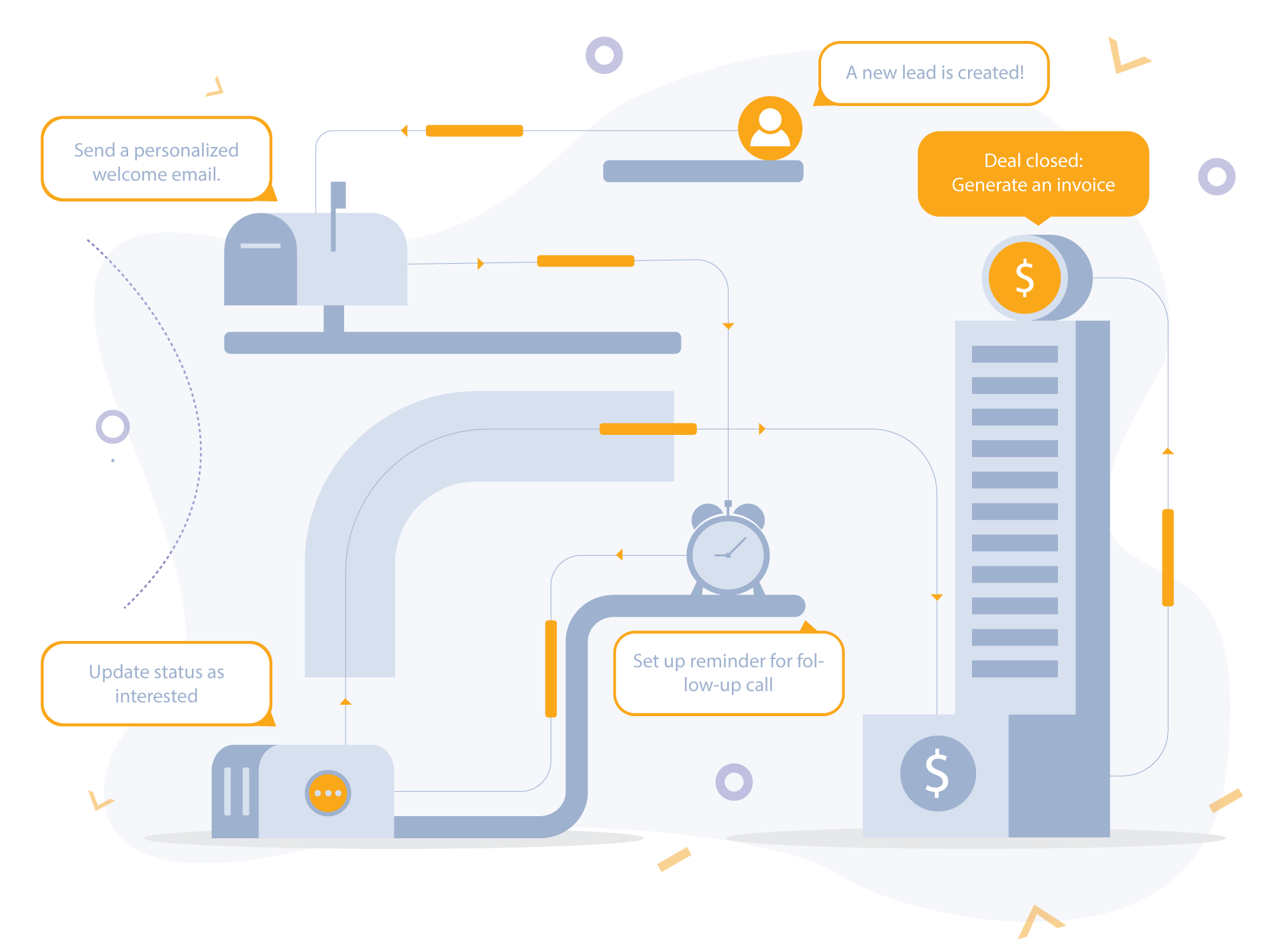Managing your customer relationships is an important and challenging job. You need to be able to keep track of your contacts, their preferences, and buying habits while trying not to annoy them with too many emails or sales pitches.
Choosing the right CRM for your marketing needs can be a difficult decision. Many factors go into this, including a budget, experience with the product, and more. But there is no need to fret! We have compiled an in-depth comparison of two popular CRMs: Redtail vs Salesforce. This blog post will walk you through what makes these two products differ from one another so that you can make an informed decision about which solution is best for your business.
What is Redtail CRM and what is used for?
Redtail CRM is a cloud-based business software that is primarily used for managing marketing and sales processes.
Redtail CRM focuses on lead generation, customer support, and feedback programs. The tools within the Redtail platform can be utilized to create personalized content such as emails or direct mailings based upon user behavior, demographics, and preferences.
Redtail CRM also integrates with several other popular software programs used by businesses, including QuickBooks, Outlook, and Google Apps.
Who uses Redtail CRM?
Redtail CRM users are typically small to medium-sized businesses who need a CRM that is both easy to use and affordable. Since Redtail CRM is web-based, it can be accessed from anywhere with an internet connection. This makes it a great choice for businesses that have employees working remotely.
RedTail vs Salesforce Features Comparison
This blog post will compare the features of Redtail and Salesforce to help you decide which CRM is the best for your marketing needs.
Salesforce is a comprehensive CRM that offers a wide range of features, including lead management, contact management, opportunity tracking, and sales pipeline reporting. It also includes built-in email marketing and social media integration.
Redtail is a more affordable CRM that offers many of the same features as Salesforce, including lead management, contact management, and opportunity tracking. It also includes built-in email marketing and social media integration. However, it does not include sales pipeline reporting or other advanced features like custom dashboards and workflow automation.
User Experience

User experience, or UX, is the process of enhancing customer satisfaction and loyalty by improving the usability, accessibility, and pleasure provided in the interaction between a customer and a company. Simply put, it’s how well your customers like using your product or service.
It’s no secret that good UX can make or break a business. Bad user experiences cost companies 25 billion dollars each year in the United States alone. And that’s just from customers who bother to complain! Chances are good that many more people simply leave your company or product altogether without ever saying a word.
So, why is UX so important in marketing?
First, good UX is attractive. If people like using your company or product, word gets around and more customers will want to try it out. The UX you offer also makes a powerful statement about the type of business you run: if users say they love how smoothly everything works on your site, that says something good about the quality of products/services you provide as well.
Second, good UX helps you stand out from the competition. If your user experience is bad compared to that of your competitors, customers will flock to them instead. But if you have a great UX and they don’t, you’ll win their business every time.
Last, but certainly not least, good UX makes customers happy. And we all know that happy customers are more likely to be loyal, return customers.
Redtail’s user experience is significantly more pleasant and satisfying than Salesforce’s. It is easier to use, navigate, and find what you are looking for. The interface is sleek and uncluttered, with a modern look that feels current and up-to-date. In addition, Redtail offers excellent customer support in case users run into any trouble.
Salesforce, on the other hand, feels dated and cluttered. The interface is not as easy to use, and it can be difficult to find what you are looking for. In addition, Salesforce does not offer customer support unless users purchase a premium subscription.
Salesforce offers customer support only if users purchase a premium subscription, while Redtail offers customer support to all users.
Salesforce’s user experience is cluttered and difficult to use, while Redtail’s user experience is sleek, easy to use, and satisfying.
Salesforce offers customer support only if users purchase a premium subscription, while Redtail offers customer support to all users. Salesforce’s user experience is cluttered and difficult to use, while Redtail’s user experience is sleek, easy to use, and satisfying. Overall, Redtail provides an excellent user experience that is sure to please customers and help your business stand out from the competition. Salesforce, while not terrible, is lagging when it comes to user experience. If you’re looking for a CRM that your customers will love using, Redtail is the clear winner.
Workflows

Workflows are simply the different “steps” in your sales funnel. For example, if you are a car dealer and you want to sell new cars (high ticket items) it’s important to see where people enter your database (lead generation), what they do once inside (nurturing them into leads), then eventually closing that lead by getting them into an appointment to see a car.
Workflows allow you as a marketer to keep track of all those steps and have visibility into how your marketing efforts are performing within each step, the number of leads generated from that step, etc.
Redtail’s workflows are very simple and easy to use. You can easily create a new workflow by clicking on the “Create New Workflow” button and then selecting the type of workflow you want to create.
Redtail has four main types of workflows you can create. First, Lead Nurturing Workflow where you can easily track prospects at every step in the sales process, from lead to close. Then use this information to decide if your program is working or not and how it could be improved. You will quickly see which campaigns are driving leads most effectively and which ones need to be tweaked.
The next type of workflow is called a “Campaign Response” workflow. This allows you to track the success of your marketing campaigns by setting up rules that determine how leads should be handled when they are received as a result of a particular campaign.
Redtail’s third type of workflow is an “Event Response” workflow, which allows you to keep track of sales activity from events. You can easily create an event response that assigns a lead or opportunity depending on the type of event and then tells RedTail how to handle it automatically.
Finally, you have Lead Inflows workflows where you can set up rules for different types of leads entering your database. For example, you might be interested in setting up rules for leads that are created through your website or other online marketing efforts.
SalesForce’s workflows allow you to track people at every step of the sales process and easily see how each activity is related to revenue generation by tracking lead status, campaign results, and opportunity status.
Salesforce gives you the ability to create workflows that are triggered by any type of activity including marketing campaigns or events as well as sales activities such as calls or deals created from a lead. It will even trigger an email workflow every time there is a change in a deal record so you can follow up with your contacts promptly.
One of the unique features of SalesForce’s workflows is that it also allows you to track and measure marketing ROI (return on investment) because you can see what revenue was generated from each workflow, who initiated it, when they did, etc., which makes for great analytics data.
In terms of workflows, Redtail is much simpler to use and SalesForce offers more complex options. However, what SalesForce lacks in simplicity it makes up for in analytics data that can help you measure the ROI of your marketing campaigns. Ultimately, which CRM you decide to go with depends on your needs and how comfortable you feel using its features.
Reporting

Reporting is one of the most important features of a CRM because it allows you to track your progress and see what is or isn’t working. With Salesforce, you can easily create reports on everything from lead conversion rates to email open rates. Redtail also offers robust reporting capabilities, making it easy to track your marketing efforts and measure their impact.
Some of the key features that Marketing teams will find useful are; First, Productivity Reports where you track how much time your team is spending on tasks and what components they may be neglecting. Second, Opportunity Reports allow you to track how many opportunities your marketing efforts are creating and converting. Finally, Email Statistics Reports show you how many emails were sent, opened, clicked through, and more.
Redtail’s reporting capabilities are extensive and customizable. You can track just about anything you want, including email opens, clicks, and conversions; social media interactions; website visits; and more. You can also create custom reports to suit your specific needs.
Redtail offers several different report types, including standard reports, activity reports, contact reports, and more. You can also save your favorite reports for easy access later on.
You can export Redtail’s reports to Excel, PDF, or CSV files for further analysis or distribution. And if you need help creating custom reports or understanding the data in your existing reports, the Redtail support team is standing by.
Salesforce offers reporting capabilities that are just as robust and customizable as those offered in Redtail; however, since they’re part of a larger suite, you can access all your other data from within your reports. That means no more exporting and importing – you can pull all your marketing data into a single report.
Salesforce’s reporting capabilities allow you to track website visits, social media interactions, email opens and click-through rates, lead conversions/completions, opportunities created by your team members or from within the system itself (like at trade shows), customer surveys completed, and more.
You can also filter your reports by date range, activity type (social media interactions or email opens), contact status, campaign name/type, lead source, product purchased – the possibilities are nearly endless! You can even create custom dashboards for quick access to any data you want to track right at your fingertips.
In terms of reporting, Redtail and Salesforce are very different. Redtail offers extensive reporting capabilities, giving you access to information on just about everything your team is doing in the marketing department. But if you need a deeper dive into this data or want to pull it all together in one place for easy analysis, Salesforce’s reporting features might be a better fit.
Third-Party Integration

Third-party integration is a crucial part of marketing. When you are integrating different software, it allows for seamless workflows across all of your business needs.
Third-party integration allows you to connect different software to automate tasks and better manage your data. This is important for marketing because it can help you track leads, customers, and sales more effectively.
When looking for a CRM, make sure to find one that has good Third-Party Integration options. This will make your life much easier when it comes to managing your marketing tasks.
Redtail’s third-party integration options are one of the best parts of their CRM. They have over 100+ plugins and integrations that you can use to connect almost any software with Redtail.
Some of the most popular third-party programs include HubSpot, MailChimp, Marketo, SalesforceIQ (formerly Rypple), Slack, Zoho, and more.
When you start using Redtail’s CRM software you can connect all of your different marketing tools to make data management seamless and easy!
Redtail’s third-party integration is a huge plus that makes their CRM stand out from the rest.
Salesforce’s third-party integration is also very good. They have over 40+ apps that you can use to connect different software with Salesforce.
Some of the most popular third-party programs include HubSpot, MailChimp, Marketo (SalesforceIQ), Pardot (SalesforceIQ), and more!
When it comes down to it their Third-Party Integration is not quite as extensive as Redtail, but it still has some great options that will make your life easier.
The bottom line here is both CRM’s have good Third-Parties for different areas of marketing. Each one offers different third-party programs to help streamline your workflow and improve data management across all of your different marketing tools.
In terms of third-party integration, both Redtail and Salesforce are good options for any marketing team.
Redtail has a ton of different third-party apps that you can use to connect almost anything with their CRM, which is great! But they also have some competitors like Marketo (SalesforceIQ) who offer a lot of the same integrations as well.
Salesforce also has a lot of different integrations, but they don’t quite have as many as Redtail. However, they do offer some unique integrations that you can’t find with any other CRM.
At the end of the day, both CRM’s are great for marketing teams and have a variety of third-party integration options to choose from. It just depends on your team’s specific needs and what programs you want to connect with your CRM.
Opportunity Management

Opportunity management is the process of tracking and managing potential sales opportunities. It includes the recording of information about an opportunity, its current status, and any action items that are associated with it.
Opportunity management is important for marketing because marketers need to be able to track how well they’ve performed in terms of nurturing leads into opportunities before sending them over to sales reps. It also allows marketers to know what they need to improve on.
It’s an important part of any effective marketing strategy, as it allows you to keep track of all the leads you’re working on, as well as prioritize and track their progress.
Redtail’s opportunity management system is very comprehensive. You can track the progress of each opportunity, as well as add notes and documents to help you keep track of everything related to that opportunity.
You can also create custom fields to track any information that’s important to you, and there are several reports available to help you track how your opportunities are doing.
Redtail’s opportunity management system is very good for marketing teams.
Salesforce’s opportunity management system is also comprehensive, but it doesn’t have some features that are available in Redtail. You can’t create custom fields or reports, so you’re stuck with what they offer.
It has a lot of features that are helpful for sales teams, but it’s not as good for marketing teams.
Salesforce’s opportunity management system is more focused on sales than marketing.
In terms of opportunity management, Redtail is the better choice for marketing teams. There are more features available, and it’s designed with marketers in mind.
Salesforce has a lot of great sales-focused features that would be good for sales reps to use, but there aren’t as many features available or a comprehensive opportunity management system for marketers to use.
Mobile

Mobile capabilities are important for any CRM because they allow you to access your data and contacts from anywhere. Redtail offers a mobile app that is available on both Android and iOS devices, while Salesforce does not have its mobile app but does offer a mobile-friendly version of its website.
Mobile is important because it gives you the freedom to work on your CRM anywhere. If you’re out of the office, you can still access your data and contacts to get your work done. The Redtail mobile app is available on both Android and iOS devices, while Salesforce does not have its mobile app but does offer a mobile-friendly version of its website.
Redtail’s mobile app is very comprehensive and offers all of the features you would expect from a CRM mobile app. You can access your contacts, accounts, opportunities, and tasks; view reports, and even create new records. The app is easy to use and has a user-friendly interface.
Redtail has a comprehensive mobile app that offers all of the features you would expect from a CRM mobile app. You can access your contacts, accounts, opportunities, and tasks; view reports, and even create new records. The app is easy to use and has a user-friendly interface.
Salesforce doesn’t have its mobile app, but the mobile-friendly version of its website is very good. It’s easy to navigate and offers all of the features you would expect from a CRM on a mobile device. You can access your contacts, accounts, opportunities, and tasks; view reports, and create new records.
In terms of mobile, Redtail and Salesforce are neck-and-neck. Both offer comprehensive mobile apps with all of the features you would expect from a CRM on a mobile device. However, Redtail’s app is available on both Android and iOS devices, while Salesforce’s app is only available on iOS devices. This could be an important consideration if you have employees that use Android devices.
Redtail has a mobile app available on both Android and iOS devices. Salesforce’s website is mobile-friendly but does not have a dedicated app. Redtail offers more comprehensive features than Salesforce in the Mobile department which could make it the better option for you depending on your needs.
Ease of Use

Ease of use is an important factor to consider when choosing a CRM for your marketing needs.
Ease of use will play a significant role in how quickly your team can learn and use the CRM. The more time it takes you to train employees, get them onboarded, and familiarize with the software – that is limited resources for other marketing initiatives.
Ease of use will depend on numerous factors such as the user interface, navigation, feature availability, and customer service.
Redtail’s ease of use is highly dependent on the user interface. For example, their drag-and-drop feature allows users to easily create new campaigns and target specific customers without writing a single line of code.
Their navigation is also simple with less clicking required for most tasks which means you can complete more actions in less time. Redtail’s “daylight” UI gives marketers the ability to see their entire pipeline at-a-glance, making it easy to identify any potential bottlenecks.
Salesforce is less dependent on user interface and more reliant on feature availability. While they do have a drag-and-drop feature, it’s not as user-friendly as Redtail.
Navigation is also more complicated than it is in Redtail, with more clicking required to get to the desired task. Salesforce does offer a “dark” UI which gives users the ability to hide or show objects and tabs depending on their needs. However, this can be confusing for first-time users.
In terms of ease of use, Redtail is the clear winner. Their drag-and-drop feature makes it easy for users to create campaigns and target specific customers without any coding required. Additionally, their navigation is simple, making it easy for marketers to complete tasks in a shorter amount of time. Salesforce’s ease of use is less dependent on user interface and more reliant on feature availability. While they do have a drag-and-drop feature, it’s not as user-friendly as Redtail’s and their navigation is more complicated than in Redtail with more clicking required to get to the desired task.
Contact Management

Contact management is important in marketing because it allows you to keep track of all your leads and customers in one place. This makes it easy to stay organized and follow up with potential sales opportunities.
Leads are an opportunity waiting on the wings, ready for action when they become customer-ready. A lead can be defined as anyone who has interacted with your company in some way, whether they filled out a form on your website or just happened to be walking by and saw your promotional materials.
A customer is someone who has already bought from you, and as such represents an existing revenue stream. It’s important to maintain relationships with your customers for them to feel valued and continue purchasing from you.
Redtail’s contact management is pretty straightforward. It starts by creating an account, which means you can start adding contacts immediately after signing up. But the real beauty here is in how those contacts are organized and labeled – a simple click will switch between your leads, customers, or prospects as needed.
Redtail also allows you to track your interactions with each contact, so you can always be sure of the last time you contacted them and what that interaction consisted of. This helps keep your sales process organized and streamlined.
Salesforce’s contact management is a little more complicated than Redtail’s but still user-friendly. To create a contact, you first need to set up a custom object – this is where all your customer data will live. From there, you can add fields for any information you want to track about each customer (including interactions).
Salesforce also offers several features for managing leads and customers, such as lead nurturing, campaign management, and reporting. However, it can be a little more difficult to find the information you need than in Redtail.
In terms of contact management, Redtail and Salesforce are both great options. Redtail is simpler to use but doesn’t offer as many features, while Salesforce is more complicated but has a wider range of features. Ultimately, which CRM you choose will depend on your individual needs and preferences.
Both CRMs have their pros and cons, but at the end of the day it comes down to what you need most from a CRM. If you’re looking for a simple way to keep track of all your leads and customers, Redtail is the way to go. But if you need more features and flexibility, Salesforce is a good option.
Social Integration

Social integration is the process of connecting and sharing information across different social media platforms.
The ability to quickly share your content on multiple social channels is essential in today’s marketing world, where customers expect real-time responses. They also want a streamlined experience that allows them to interact with you through one or all of their preferred networks – be it Facebook, Twitter, Pinterest, or LinkedIn.
With social integration, your marketing team can easily share any content that you want to promote across all of your networks without having to manually enter the same message multiple times.
Redtail’s social integration tool allows you to quickly and easily share content from your CRM on all of your social media channels. You can also use it to monitor your social media feeds for any mentions of your company or products, and then respond directly from within Redtail.
This tool is a great way to keep your social media accounts active and engaged with your customers, even when you’re not constantly posting updates!
SalesForce’s Chatter allows users to share content from their CRM with any social media platform. This includes Facebook, Google+, Twitter, and LinkedIn. In addition, they can also monitor these channels for any posts related to them or their company and then respond directly from within Salesforce.
This tool is a great way to keep your social media accounts active and engaged with your customers, even when you’re not constantly posting updates!
Both Redtail’s and SalesForce’s social integration tools are great ways to automate your social media management. However, Redtail’s tool lets you post to more social networks than SalesForce.
This shows that the best CRM for marketing is Redtail!
In terms of social integration, it’s clear that Redtail CRM is the superior option. It allows you to post on more social networks, which makes it easier for your marketing team to share content across all of their channels without having to manually enter the same message multiple times.
Also, since social integration involves sharing content from your CRM directly with less effort involved, this will help keep your social media accounts active and engaged with your customers. So, if you’re looking for an easy way to boost your marketing efforts, Redtail is the best CRM for you!
Analytics & Dashboard

Analytics & dashboard is a feature that allows you to track your progress and measure your success. With this information, you can make improvements to your campaigns and strategies. It is important in marketing because you need to be able to track your progress and make changes accordingly.
Analytics is a feature that is used to track your campaigns, marketing efforts, and improvements. This information will be laid out in an easy-to-understand format that can allow you to see what is working well for your business and the areas that need improvement.
The dashboard allows you to get a quick look at how effective your current advertising campaign is, without having to dig through your analytics. It can give you information as ad spend, clicks, and conversions to help figure out the best course of action for improving it or continuing as-is.
Redtail’s Analytics & Dashboard is very user-friendly and easy to navigate. The layout is simple, which makes it easy to find the information you need. There are several different options for viewing your data, so you can customize it to fit your needs. You can also export your data into a variety of formats for further analysis or sharing with others.
Redtail’s analytics feature is a great way to view your progress and determine whether or not you are reaching the goals of your campaign. It also gives insight into what areas need improvement so that you can optimize for success.
Redtail’s dashboard is also very user-friendly. It provides a quick overview of your data, so you can see how your campaigns are doing at a glance. You can customize it to show the information that is most important to you, and export it into different formats for further analysis or sharing with others.
Salesforce’s analytics & dashboard is also very user-friendly. The layout is simple and easy to understand, so you can find the information you need quickly. There are several different options for viewing your data, so you can customize it to fit your needs. You can also export your data into a variety of formats for further analysis or sharing with others.
Salesforce’s analytics feature is a great way to view your progress and determine whether or not you are reaching the goals of your campaign. It also gives insight into what areas need improvement so that you can optimize for success.
Salesforce’s dashboard allows you to get a quick look at how effective your current advertising campaign is, without having to dig through your analytics.
In terms of analytics & dashboard, both Redtail and Salesforce have some great features that can help you track your marketing progress and measure your success. However, we feel that Redtail’s analytics & dashboard is a bit more user-friendly and easier to navigate. It also provides more options for viewing your data, so you can customize it to fit your needs. Additionally, the layout is simple, making it easier to find the information you need.
Lead Management

Lead management is the process of tracking, managing, and nurturing leads through the sales pipeline until they are converted into customers. It’s a critical part of any successful marketing strategy, as it helps you ensure that your efforts are focused on quality leads that have the greatest potential to become paying customers.
Lead management is one of the most important parts of marketing because it ensures you are spending your time and resources on qualified leads that have shown interest in your company’s products or services. Unfortunately, many marketers struggle with lead management due to what they perceive as a lack of tools offered by their CRM vendor. This often results in poor data quality, wasted time and effort, and unqualified leads.
Redtail’s lead management capabilities are built right into the platform. The Lead Scoring feature automatically evaluates incoming leads based on pre-defined criteria, allowing you to prioritize your prospects for follow-up and ensure that your efforts are focused on generating qualified opportunities.
Redtail’s lead scoring feature makes it easy to pre-qualify leads.
Salesforce, on the other hand, does not include a built-in lead management function within its CRM platform. This means that marketers must rely on third-party solutions to manage their leads and ensure they are moving through each stage of the sales pipeline.
When third-party solutions are required, marketers must decide which one to use. This can be challenging given that there is no single solution designed specifically for Salesforce, meaning you’ll need to compare several different options and choose based on your specific criteria (price point, ease of use, etc.).
The lack of lead management capabilities in Salesforce is a major drawback for marketers.
In terms of lead management, Redtail and Salesforce are fairly evenly matched. However, Redtail’s lead scoring feature makes it easier to pre-qualify leads, which can be a major advantage for businesses that want to focus their efforts on generating qualified opportunities. Ultimately, the best CRM for your marketing needs will depend on your specific requirements and preferences. So, be sure to take the time to research your options before making a decision.
Free Trial
Getting a free trial can be an extremely valuable option for many companies. It is important because it allows the potential customer to get used to using your product before they have to pay money, which oftentimes makes them more likely to purchase and subscribe.
Redtail’s free trial offers unlimited access to their CRM for 14 days. This trial is great for those who want to explore the features of Redtail or want to test it out before making a purchase.
Redtail offers a free trial, which may make it more attractive to potential customers. Another advantage is that you can also install Redtail on your server where they will host all of the data for you so there are no extra fees or security risks with having them store your information with their cloud-based CRM.
Salesforce also offers a free trial, which is important for those who want to test out the features of this CRM before making a purchase. The trial lasts for 14 days and you have access to all of the features of Salesforce. You can also use Salesforce’s CRM on your server where they will host all of the data for you so there are no extra fees or security risks.
In terms of a free trial, both Redtail and Salesforce offer great options for those who want to explore the features of each CRM before making a purchase. However, Redtail’s free trial is more advantageous because it offers unlimited access to their CRM for 14 days, while Salesforce only offers 14 days of access.
Pricing

Note: Prices may be subject to change.
Pricing is important for a couple of reasons. First, it helps businesses determine whether they can afford a certain product or service. Second, it allows customers to compare products and services to see which one offers the best value. Finally, it can help businesses attract new customers by advertising lower prices than their competitors.
Redtail’s pricing is based on the number of contacts you want to store in your customer database. They offer five different plans, ranging from $19 per month for 500 contacts up to $699 for 25,000 contacts.
The basic plan costs just under 50 dollars a month and includes all the essential marketing tools that small businesses need to get started. Also, our plan includes additional features, such as email marketing and lead scoring. You can find out more information on our pricing page.
SalesForce’s prices vary depending upon the size of your business and what you need from a CRM system. The cheapest option is $65 per user per month for up to five users.
Salesforce pricing starts at a minimum of about 150 dollars per month and goes up from there depending on the size of your business and what you want from a CRM system.
Salesforce’s pricing is based on the number of users you want to add to your account. They offer three different plans, ranging from $25 per month for one user up to $300 per month for 25 users.
In terms of pricing, Redtail is a much better option compared to SalesForce. Redtail’s pricing starts at just under 50 dollars a month, which includes essential marketing tools that small businesses need to get started. Also, our plan includes additional features such as email marketing and lead scoring. You can find out more information on our pricing page. On the other hand, SalesForce’s prices vary depending upon the size of your business and what you need from a CRM system. The cheapest option is $65 per user per month for up to five users, which means that SalesForce would cost you around 250 dollars every single month!
Frequently Asked Questions
Who’s more expensive? Salesforce CRM or RedTail EDI?
In terms of expensiveness, Salesforce CRM is more expensive than RedTail EDI. Salesforce can be quite costly for businesses that are just starting out, whereas RedTail EDI has a range of pricing options to fit any company’s budget. That said, it’s important to remember that you get what you pay for; with Salesforce, you’re getting a powerful marketing and sales platform that can be incredibly beneficial to your business.
Which software includes more/better features?
The software that offers better and more features is Salesforce.
Salesforce has a customizable user interface (UI): Depending on your business preferences, you can set up a UI that works for you and other users in your company. This allows everyone to use it more efficiently without feeling confused or overwhelmed by its complexity. You can also manage an unlimited number of leads, accounts, contacts, and opportunities with Salesforce. Another feature of salesforce is that you can manage your email marketing and social media in one place. You can also connect with customers via text messaging, which is a great option for increasing sales conversions. Salesforce’s reporting engine provides an enormous amount of data to marketers about their lead generation campaigns so they know what works best for them.
Redtail does not offer the same level of customization for users. Its UI is more traditional and less flashy than Salesforce. Additionally, it has limited lead management capabilities in comparison to Salesforce. If your business depends on managing a high volume of leads, you might find Redtail’s product a little limiting.
Which is the best CRM for financial advisors?
The best CRM for financial advisors is Salesforce.
Redtail has excellent reporting features that can provide you with all the information about your client in one place, but Salesforce is enterprise-level software that’s more complex and better suited for larger teams of financial advisors.
SalesForce also integrates easily with other software such as Google Docs and Microsoft Excel, which can make it a more powerful tool for your marketing needs. If you’re looking for a CRM that will help you manage your clients and their data effectively, then Salesforce is the best option.
If you’re not sure whether Salesforce or Redtail is the best CRM for you, then speak to a representative from each software company and ask them which program would be better suited for your needs. They’ll be able to provide you with more information and help you make a decision.
What does a CRM for financial advisors typically include?
Financial advisors are typically looking for social media, lead capture, and reporting capabilities. Social Media Management, Lead Capture & Leads Tracking, Reporting & Analytics are all important features to look for in a CRM.
Salesforce is typically seen as the best option for these needs, as it offers robust social media management capabilities, lead capture forms that can be customized and tracked, and detailed reporting and analytics. However, Redtail also offers strong social media management tools, good lead capture options, and robust reporting features.
Which CRM is the best for your marketing needs? It depends on what you are looking for in a CRM. If you need robust social media management capabilities, lead capture forms that can be customized and tracked, and detailed reporting and analytics, then Salesforce is likely the best option for you. However, if you are looking for a more affordable option that also offers strong social media management tools, good lead capture options, and robust reporting features, then Redtail might be the better option.
Which is better, Salesforce Financial Services Cloud vs RedTail?
Between Salesforce Financial Services Cloud and Redtail, it can be tough to decide which CRM is the best for your marketing needs. Both have their advantages and disadvantages, but in the end, it depends on what your specific needs are.
Salesforce Financial Services Cloud is great for businesses that need a lot of automation and features built-in. It’s perfect for growing businesses that want to be able to scale up as they grow because it can be adapted and expanded upon quite easily. It also offers a lot of great integration options so you don’t have to set everything up from scratch and use other products or services that may not work well with your system.
RedTail is ideal for businesses that want something simple, easy-to-use, and affordable. It’s best for startups or businesses who are starting to grow but aren’t quite ready to invest in something like Salesforce Financial Services Cloud yet. While it doesn’t have as many features, RedTail is still very effective at what it does do because all of the most important tools you need for marketing automation are included.
In the end, it depends on what you’re looking for and your specific needs. If you want something easy to use and has a lot of features, go with Salesforce Financial Services Cloud. If you want something more affordable and simple, go with RedTail. Whichever CRM you choose, make sure to take the time to learn it inside and out so you can get the most out of it!
Bottom Line: Which is Better – Salesforce CRM or RedTail?
At the end of the day, which CRM you choose depends on your specific needs as a business. If you are looking for an all-inclusive system that can handle everything from sales and marketing to customer service and accounting, Salesforce is likely your best bet. However, if you are primarily looking for a powerful CRM tool to help you manage your marketing efforts, RedTail offers the most comprehensive set of tools out there for this purpose.
The bottom line is both CRMs are great platforms with strong features that can help streamline many aspects of business management. Therefore, it comes down to what your specific needs are as a business and which one best fits those requirements.
Salesforce is a great CRM for businesses that are looking for an all-inclusive system to manage sales, marketing, customer service, and accounting. However, if you are primarily looking for a powerful CRM tool to help you manage your marketing efforts, RedTail offers the most comprehensive set of tools out there. So, the bottom line is that both CRMs are great platforms with strong features to help streamline many aspects of business management.




